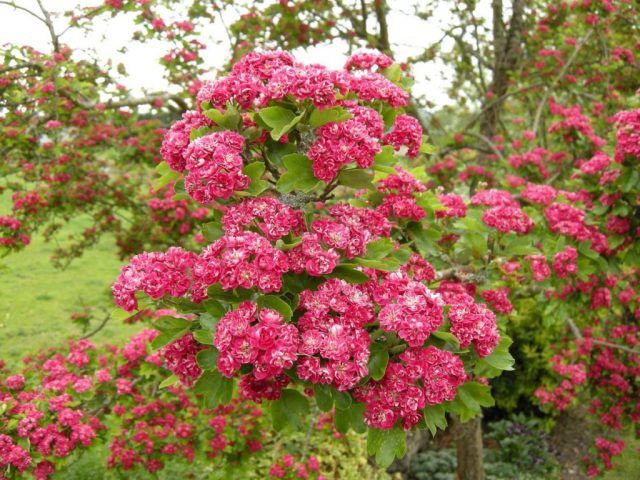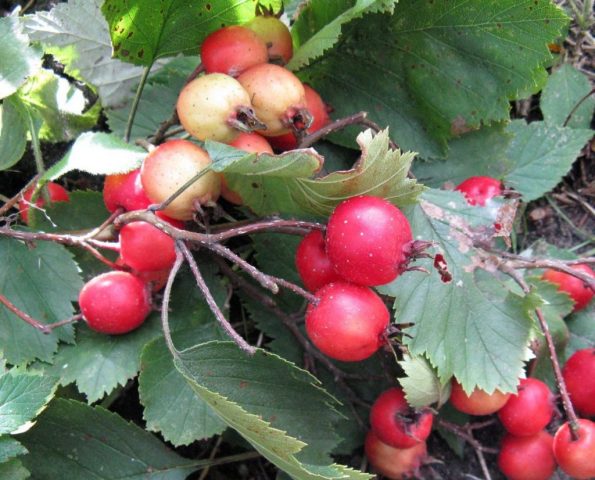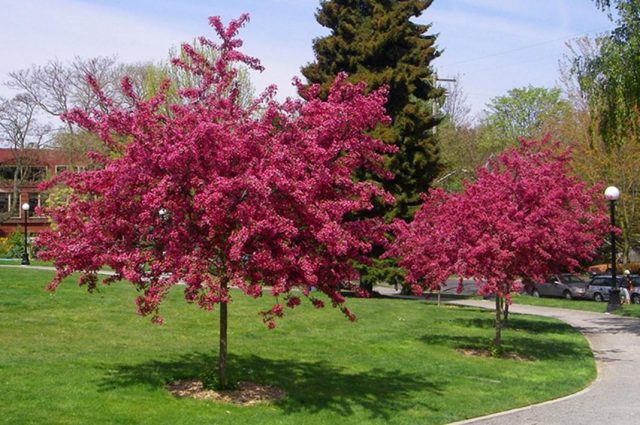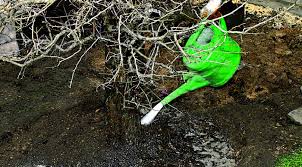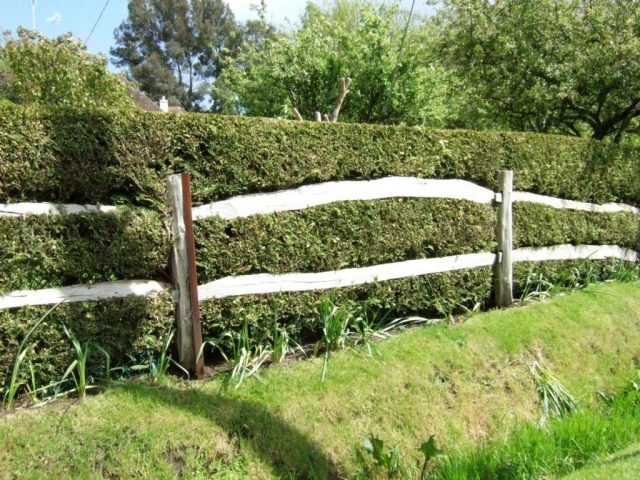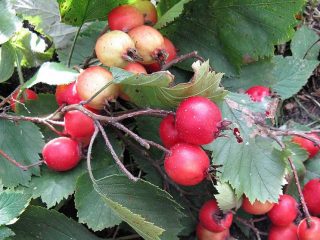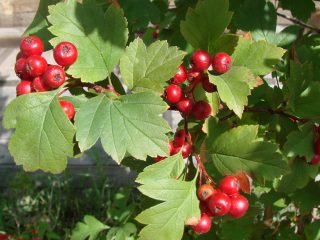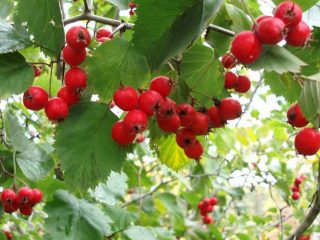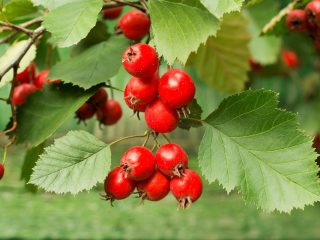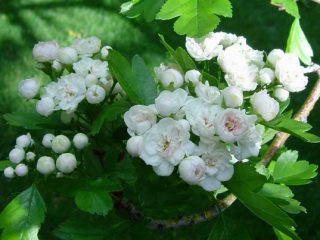Content
Hawthorn Paul Scarlet is a low, lush shrub that blooms with bright, large inflorescences. It is considered a real decoration of the garden. Of all the types of hawthorn, this is the most popular. Blooming Pauls Scarlet is very similar to sakura.
History of selection and distribution area
The Paul Scarlet hawthorn was grown in England in 1850. And in 1858 it was registered and received all possible awards at a plant exhibition in Foggy Albion. A quality certificate was received in 2002.
The shrub is common in Great Britain and Western Europe. In Eastern Europe it is no less popular culture.
Description of the variety
The Paul Scarlet shrub grows up to 6 m in height and up to 4 m in width. It has a spherical lush crown with spreading, slightly drooping branches. Young shoots are often strewn with thorns and fluff, and have a reddish tint. The length of the spines is 2.5 cm.
You can appreciate the beauty of the Paul Scarlet hawthorn from the photo.
The leaves of the bush are quite large, emerald green, absolutely smooth, like varnish, and ovoid in shape. Appear on the tree in early spring.
Paul Scarlet hawthorn flowers are velvety, scarlet, carmine, and quite large. The tree blooms in early May. At the beginning of June, the flowers fall off. The inflorescences are large, umbrella-shaped.
Hawthorn Paul Scarlet bears little fruit. Rare fruits look like small red apples, spherical or ovoid in shape.
The root system is powerful and strong. The shoots lie quite deep and are sensitive to soil compaction.
Paul Scarlet hawthorn can be grown throughout Europe, where severe frosts do not occur. The culture is found even in Siberia and the Far East.
Main characteristics
Common hawthorn Pauls Scarlet does well in urban areas. Prefers open, well-lit areas.
Drought resistance, frost resistance
The Pauls Scarlet variety is drought and frost resistant. This is due to a powerful root system that grows into the deep layers of the earth. Only young plants and shrubs need watering during the dry period.
Resistance to diseases and pests
With proper care, the Pauls Scarlet variety is not susceptible to pests and diseases. But it can become infected from garden and fruit plants.
In summer, Scarlet hawthorn suffers from aphids and spider mites. At the same time, the leaves of the plant turn yellow and curl. If you do not treat it in the spring, the rhizome will be undermined by the cutworm or May beetle. In this case, the root will be completely destroyed.
The leaves of the plant are affected by the following diseases: powdery mildew, gray rot, rust.
Planting and caring for hawthorn Paul Scarlet
Planting a Paul Scarlet hawthorn is quite simple, as is caring for it. But in order for the bush to bloom magnificently and beautifully, everything must be done correctly.
Recommended timing
Paul Scarlet hawthorn is recommended to be planted in open ground in the fall, in mid-October, before frost. In warm spring, in mid-April, you can also plant hawthorn, but in autumn it is preferable. The seedling must overwinter and harden off.
Selecting a suitable location and preparing the soil
Common hawthorn Paul Scarlet grows and blooms well in open areas in sunny areas. It also does well in partial shade, but Pauls Scarlet should not be completely shaded.
Before planting Pauls Scarlet, the soil is thoroughly loosened and a hole is made. The depth of the hole should correspond to the length of the rhizome. The root collar after digging should be at ground level. The bottom of the pit is covered with a 10 cm layer of crushed stone. On top is a corresponding layer of sand. This will be drainage. The soil for digging is mixed with humus, sand and peat in equal parts. You can add 40 g of lime to the soil mixture.
What crops can and cannot be planted nearby?
Hawthorn Paul's Scarlet is a tall crop, so it can be planted with all types of plants. Avoid planting hawthorn next to trees that can shade it. Well Paul Scarlet grows up surrounded by his fellows. Entire alleys of blooming hawthorn are often planted. The main thing is not to obscure it.
Landing algorithm
The seedling is lowered into a prepared planting hole with drainage, the roots are straightened, and the trunk is placed strictly vertically.Fill the hole with a mixture of soil with peat, sand and humus. Later they trample down. After Pauls Scarlet, water thoroughly and loosen the soil.
Aftercare
In order for the Paul Scarlet hawthorn to grow quickly and bloom luxuriantly, it needs proper and careful care. Feeding and pruning are important components of this procedure.
Trimming
In open areas, the hawthorn crown forms correctly and does not need pruning. In the fall, the tree is sanitized: all old shoots and dry branches are removed.
Shrubs older than 10 years require anti-aging pruning. It is performed in the fall or spring until the buds swell. The procedure consists of removing several old branches and thinning out the shoots.
In order to get a tree from a bush, the lower branches of a young seedling are cut off from the moment of planting. Only one of the strongest branches is left; after a few years it will become a trunk.
Preparing for winter
In late autumn, the trunk and lower branches of the thorny hawthorn Pauls s Scarlet are wrapped. To do this, use burlap or any other insulation in several layers. The protection is tied with a rope on top.
Despite the fact that this variety of hawthorn is frost-resistant, it does not tolerate temperatures below - 20 C°. Young shoots and buds may be damaged. Young trees under 10 years old should be wrapped especially carefully. Later, Pauls Scarlet becomes more resistant to low temperatures.
Watering
If the summer is dry, Pauli's hawthorn needs watering. It is carried out no more than once a month. 1.5-2 buckets of water are poured under one bush. As soon as it is absorbed, the soil is loosened. Young seedlings are watered more often: 2 times a month.After the soil dries, it is recommended to dig up the tree trunk area.
Top dressing
For abundant flowering in the spring, Paul Scarlet hawthorn is topped up with fertilizers. It is good to use organic fertilizer. To do this, manure is diluted in a bucket of water and the mixture is added to the plant. For one bush you need to take 10 liters of solution. Feeding is done once a month throughout the summer season.
Rodent protection
In autumn, the bed around the Paul Scarlet bush is carefully cleared of fallen leaves and wilted plants. After pruning, all plant residues are burned. This will prevent the appearance of rodents in the garden. The insulation for the tree trunk also serves as protection against animals. If rodents are already infested in the garden, set traps for them and spread poison.
Diseases and pests, methods of control and prevention
Hawthorn Paul Scarlet is susceptible to attack by spider mites and aphids. If the bush begins to shed leaves out of season, and the fallen leaves are dry and curled, they are damaged by insects.
Armyworm and Mayweed attack the root and can destroy it in a short period of time. As soon as beetles appear on the crown of the tree, it is necessary to spray the foliage with insecticides. The barrel is also subject to processing.
Rusty spots on leaves and holes are a sign of aphids. It's easy to deal with. The tree is treated with any effective fungicide.
Common hawthorn Paul Scarlet is susceptible to diseases of fruit trees:
- powdery mildew;
- perforated spotting;
- rust;
- Clusterosporiosis.
To prevent diseases in early spring and late autumn, the plant is treated with fungicides. You can also use traditional methods. In the spring, the crown of the Paul Scarlet hawthorn tree is powdered with a mixture of tobacco dust and ash in equal parts.
Application in landscape design
Hawthorn Paul Scarlet is used in landscape design as a hedge. Often this beautiful plant is used to decorate alleys and rockeries. Decorative hawthorn Pauls Scarlet looks good as a centerpiece in any flower bed and garden. A lush, spreading plant fits well into the coastal space of natural and artificial reservoirs.
Conclusion
Hawthorn Paul Scarlet is a beautiful, unpretentious crop. It can be grown in any region. Pauls Scarlet looks impressive in the form of a bush and tree. Pauls Scarlet hawthorn flowers are distinguished not only by their bright appearance, but also by their wonderful aroma. It is quite simple to grow, and the area of application of the shrub as an ornamental plant is quite extensive.
Reviews
Reviews about hawthorn Paul Scarlet are only the most positive. It's hard to find a person who wouldn't like him.
